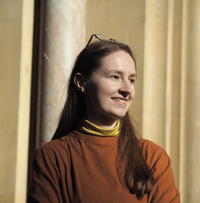How can clay be a ‘cognitive’ material?

Anna Barona is a DPhil student at the School of Archaeology. Her specialism is cognitive archaeology and anthropology, a field that seeks to understand varieties of past and present human thought. In particular, she is interested in the relationship between cognition and material culture in the long-term.
Her DPhil research focuses on the cognitive and creative possibilities of clay. She is passionate about interdisciplinary research and is interested in how archaeology can be put into fruitful dialogue with philosophy and cognitive science.
What is cognitive archaeology?
Cognitive archaeology is a rapidly growing field that seeks to understand the past – and the present – of the human mind. As you might imagine, that’s quite a big task! That’s why the field is profoundly interdisciplinary, bringing together archaeology, anthropology, psychology, philosophy of mind, and evolutionary biology. There is also no one way to do cognitive archaeology. Some perspectives focus on the evolution of the human mind, some study the similarities and differences in cognition across cultures, while others are interested in the emergence of conceptual and symbolic thought. The methods of cognitive archaeology range from experimental replications of ancient tools to understand the particular skills involved in making and using them to more theoretical discussions about what the mind is.
Archaeology adds two key things to our understanding of the mind: a long-term perspective and a vast material record of human life, creativity, and thought. We can look at things like stone tools, body ornaments, and cave art to understand how human thinking entangled with the material world and how this changed over time. In fact, emerging research in cognitive science suggests that cognition does not just happen in the brain, but is spread out across a complex brain-body-environment system. This means that the objects we use can become part of our thinking and therefore part of our minds.
Have you ever used a map to find your way? Written something down so you don’t forget? Or used your fingers to count? These are all examples of cognitive extension – ways of delegating cognitive tasks to material things to make them easier for you. Archaeology shows that this is not just a modern phenomenon but something that probably stretches back to the emergence of the earliest stone tools several million years ago. This research is reversing the narrative that more complex brains led to more complex technology; instead, it looks like our interactions with things could have shaped the evolution of our minds.
How can clay be a 'cognitive' material?
As a material, clay offers the human body many opportunities for action: it can be grasped, shaped, pulled, pinched, carried, pushed – and the list could go on. Add to it elements like a potter’s wheel, heat, water, or a stylus and the list expands even further. But these material possibilities also have a cognitive dimension. How so?
In archaeology, the framework of Material Engagement Theory argues that it is not just brains that impose forms and concepts onto the material world, but that the material world ‘acts back’ and participates in the creation of those forms and concepts by virtue of its material characteristics. This two-way relationship means that interacting with materials can create new opportunities for our minds that were not there without them. For example, think of literacy. This cognitive skill can’t emerge – and indeed does not make sense – without its material counterpart, writing. Clay actually played an important role in the emergence of literacy over the past 5,000 years or so. Some of the earliest writing we know of comes from clay tablets from the ancient Near East. The portability of clay tablets, their capacity to provide a surface for inscription, and their relative durability were all aspects that scaffolded the development of sophisticated writing from simple mark-making.
Even today clay offers us a multitude of possibilities for doing, thinking, and feeling. Skilled potters can become so attuned to their material that it becomes an extension of them and their creative consciousness. Making things out of clay can have therapeutic qualities – it can calm our minds through repetitive and tactile motions or provide a tangible material through which to express and process our feelings. It also allows us to extend our temporal perception, in a way. The mudbrick, pottery, figurines and other clay items that survive from the past provide a material basis for connecting with the people from the past and their own ways of doing, thinking, and feeling.



